| Reading guide | The rsync tool is used to synchronize files and directories from one location to another. The location of synchronization can be on a local server or a remote server. |
stay Centos Use the following in command Install rsync:
[root@localhost ~]# yum -y install rsync
Example 1: synchronize two directories in this machine
To synchronize two directories on the local computer, use rsync -zvr command:
[root@localhost ~]# rsync -zvr /var/log/ /root/temp/ sending incremental file list btmp dnf.librepo.log ... sssd/sssd_implicit_files.log sssd/sssd_nss.log tuned/tuned.log sent 516,136 bytes received 605 bytes 1,033,482.00 bytes/sec total size is 5,451,242 speedup is 10.55
Parameter interpretation:
- -z enable compression
- -v output details
- -r means recursion
Check the / root/temp directory and find that rsync does not retain a timestamp during synchronization.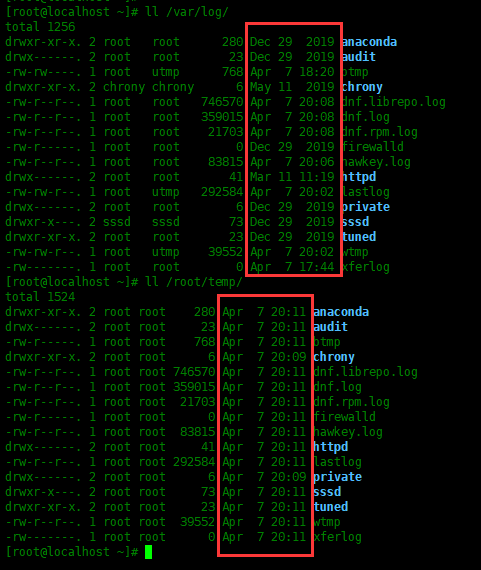
Example 2: use rsync -a to retain the timestamp during synchronization
The - a option of the rsync command indicates archive mode- A option recursive synchronization, reserved symbolic links, reserved permissions, reserved timestamps, reserved owners and groups.
Now execute the following command and view the time of the file:
[root@localhost ~]# rsync -azv /var/log/ /root/temp/ sending incremental file list ./ btmp dnf.librepo.log dnf.log dnf.rpm.log ... sssd/sssd_nss.log tuned/ tuned/tuned.log sent 516,231 bytes received 629 bytes 1,033,720.00 bytes/sec total size is 5,451,789 speedup is 10.55
As shown below, rsync retains the timestamp during synchronization.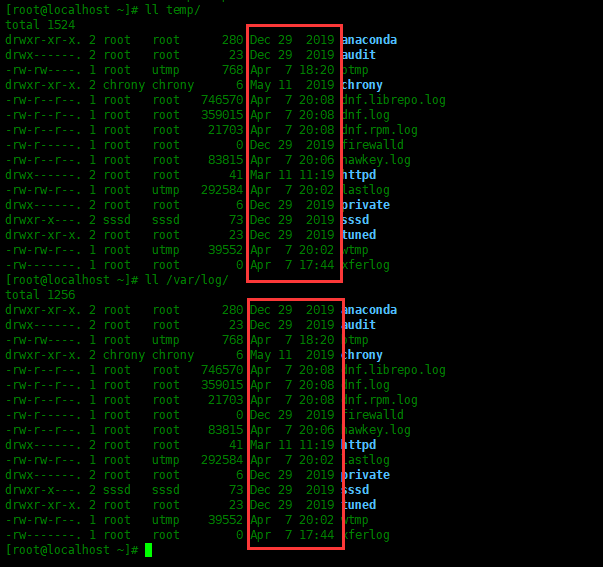
Example 3: synchronize files from local to remote directory
rsync allows you to synchronize files / directories between local and remote systems, provided that rsync is installed on both local and remote systems, otherwise the following information will be prompted:
[root@localhost ~]# rsync -avz /root/temp/ root@192.168.43.137:/root/temp root@192.168.43.137's password: sending incremental file list created directory /root/temp ./ btmp dnf.librepo.log dnf.log dnf.rpm.log ... sssd/sssd_nss.log tuned/ tuned/tuned.log sent 516,231 bytes received 662 bytes 206,757.20 bytes/sec total size is 5,451,789 speedup is 10.55
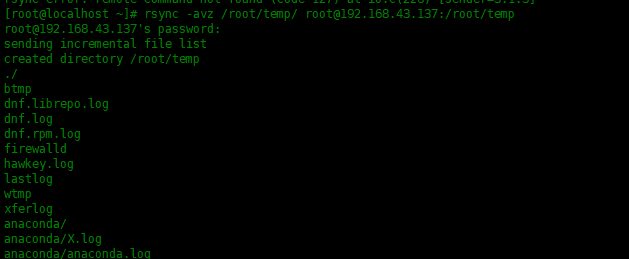
The following is to view the synchronized directory in the remote system: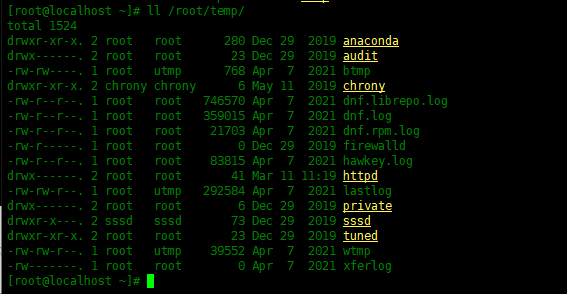
As you can see above, you need to enter a password when synchronizing. Sometimes you don't want to enter a password when backing up files from the local server to the remote server. You can set a password free login between the two hosts.
Example 4: synchronize files from remote directory to local directory
To synchronize files from the remote system to the local, specify the remote path in the source and the local path in the target as follows:
[root@localhost ~]# rsync -avz root@192.168.43.137:/root/temp /root/temp root@192.168.43.137's password: receiving incremental file list temp/ temp/btmp temp/dnf.librepo.log temp/dnf.log ... temp/tuned/ temp/tuned/tuned.log sent 634 bytes received 516,247 bytes 206,752.40 bytes/sec total size is 5,451,789 speedup is 10.55

Example 5: do not overwrite the modified file at the target location
If the file is modified in the destination location, we may not want to overwrite the file with the old file in the source location. You can do this with the - u option. In the following example, test. Exe is set locally Txt file modified the content. It will not be tested by the remote system Txt file overwritten by:
# Check test. In the temp directory of the remote system Txt file size [root@localhost ~]# ssh root@192.168.43.137 ls -l /root/temp root@192.168.43.137's password: total 4 -rw-r--r--. 1 root root 7 Apr 7 2021 test.txt # Check the test.exe in the temp directory of this machine Txt file size, local test Txt file has been modified, so it is better than test.txt in the remote system Txt file large [root@localhost ~]# ll /root/temp/ total 4 -rw-r--r--. 1 root root 77 Apr 7 21:10 test.txt # Perform rsync -avzu synchronization [root@localhost ~]# rsync -avzu root@192.168.43.137:/root/temp /root/ root@192.168.43.137's password: receiving incremental file list sent 25 bytes received 76 bytes 40.40 bytes/sec total size is 7 speedup is 0.07
Let's check the test in the / root/temp directory of this machine Txt is overwritten: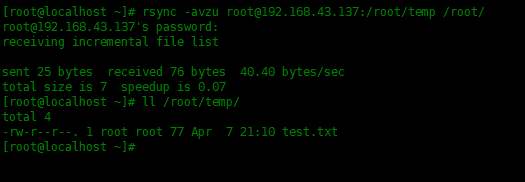
Found not covered.
Example 6: viewing rsync progress during transmission
Use the -- progress option to display the detailed progress of rsync execution, as shown below:
[root@localhost ~]# rsync -avz --progress /root/temp/ root@192.168.43.137:/root/temp

Example 7: delete files in the target directory that do not exist in the source directory
If the file does not exist in the source but in the destination, you may want to delete the file on the destination during rsync synchronization. In this case, use the -- delete option:
# Check the files in the source directory [root@localhost ~]# ll /root/temp/ total 0 -rw-r--r--. 1 root root 0 Apr 7 21:46 name.csv # Check the files in the target directory [root@localhost ~]# ssh root@192.168.43.137 ls -l /root/temp root@192.168.43.137's password: total 944 drwxr-xr-x. 2 root root 6 Apr 7 2021 anaconda drwx------. 2 root root 6 Apr 7 2021 audit -rw-------. 1 root root 0 Apr 7 2021 btmp -rw-------. 1 root root 0 Apr 7 2021 btmp-20210406 drwxr-xr-x. 2 root root 6 Apr 7 2021 chrony -rw-------. 1 root root 8432 Apr 7 2021 cron -rw-------. 1 root root 12200 Apr 7 2021 cron-20210221 -rw-------. 1 root root 48130 Apr 7 2021 cron-20210228 -rw-------. 1 root root 3910 Apr 7 2021 cron-20210308 -rw-------. 1 root root 22455 Apr 7 2021 cron-20210406 -rw-------. 1 root root 383369 Apr 7 2021 dnf.librepo.log -rw-------. 1 root root 476949 Apr 7 2021 dnf.librepo.log-20210221 # rsync uses the -- delete option to delete files in the target directory that do not contain the source directory [root@localhost ~]# rsync -avz --delete /root/temp root@192.168.43.137:/root root@192.168.43.137's password: sending incremental file list deleting temp/chrony/ deleting temp/audit/ deleting temp/anaconda/ deleting temp/dnf.librepo.log-20210221 deleting temp/dnf.librepo.log deleting temp/cron-20210406 deleting temp/cron-20210308 deleting temp/cron-20210228 deleting temp/cron-20210221 deleting temp/cron deleting temp/btmp-20210406 deleting temp/btmp temp/ temp/name.csv sent 123 bytes received 281 bytes 161.60 bytes/sec total size is 0 speedup is 0.00
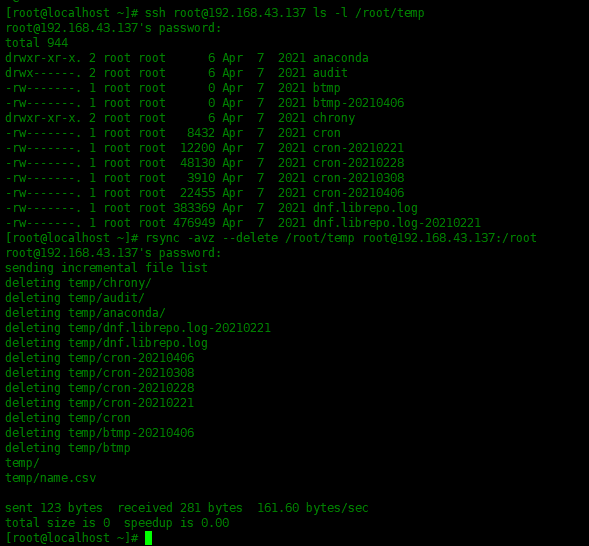
Check whether the target directory is deleted:
Example 8: include and exclude modes during file transfer
rsync allows you to provide a mode to include and exclude files or directories during synchronization.
[root@localhost ~]# rsync -avz --include 'P*' --exclude '*' root@192.168.43.137:/var/lib/rpm/ /root/temp/

In the above example, it includes only files or directories that start with 'P' and excludes all other files.
Example 9: do not transfer large files
You can use the rsync -- max size option to tell rsync not to transfer files larger than the specified size.
[root@localhost ~]# rsync -avz --max-size='1M' root@192.168.43.137:/var/lib/rpm/ /root/temp/
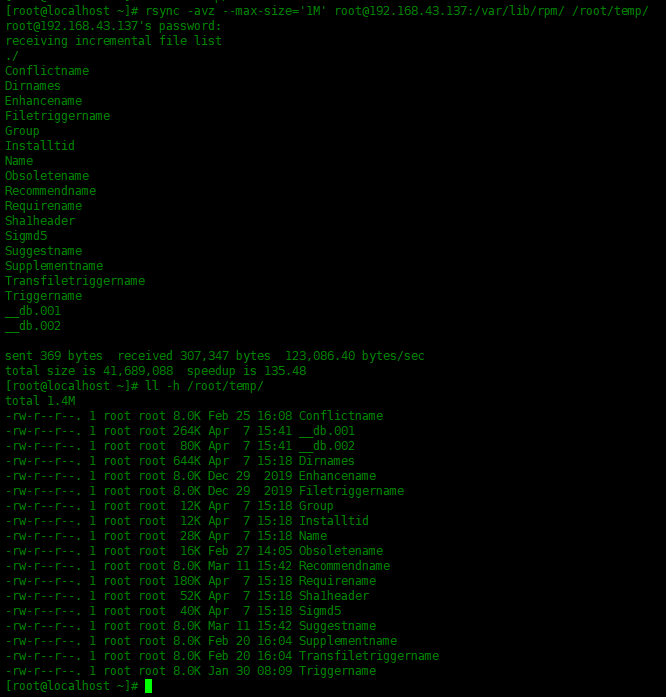
--Max size = 1M causes rsync to transfer only files less than or equal to 1M. The units can be K,M,G, etc.
You can also use the -- min size = parameter to specify the minimum file size to transfer.
summary
The rsync tool is used to synchronize files and directories from one location to another. The location of synchronization can be on a local server or a remote server.